Gasfunkenstrecke D.R.P. 299593 Elektrodenabstand 6 cm, 278002
Gas Spark Gap Tube (Rectifying Valve)
Tube éclateur à gaz (Soupape)
D.R.P. = Deutsches Reichspatent • Brevet impérial allemand • German imperial patent.

En raison de leur construction, il était absolument nécessaire que le courant passe à travers un
tube à rayons X dans la bonne direction, c'est-à-dire, de l'anticathode vers la cathode.
Lorsque le courant passe en sens inverse, non seulement il ne produit pas de rayons X,
mais le tube lui-même devient rapidement endommagé par les particules métalliques pulvérisées par
l'anticathode, qui fonctionne à ce moment en tant que cathode. Il est même possible que le flux de
rayons cathodiques émis par l'anticathode en direction des parois du tube soit suffisamment intense
pour perforer le verre.
L'effet de redressement est provoqué par le champ inhomogène, dû au fait qu'une électrode
est une pointe, l'autre une plaque. Il n'est pas nécessaire d'avoir une tension aussi élevée pour envoyer une
étincelle entre les électrodes lorsque la plaque est négative que lorsqu'elle est positive.
La pointe doit donc être l'anode par le sens souhaité du courant.
Il n'a pas été possible de trouver un brevet allemand pour ce système pointe/plaque scellé
dans une ampoule de verre, mais il était probablement couvert par un brevet de Siemens datant de 1901
qui stipule que l'éclateur doit être enfermé dans un tube de verre. En 1916, lorsque le brevet Siemens a expiré,
Reiniger, Gebbert & Schall ont déposé un brevet pour remplir l'ampoule d'un gaz chimiquement inactif, par
exemple le CO2, afin d'éviter la corrosion. Il s'agit du brevet DRP 299593 qui est gravé sur
le tube présenté. Dans les soupapes de ce type, la distance entre les électrodes
(« Elektrodenabstand ») pouvait être de 6 ou 10 cm.
La soupape ne porte aucune indication de fabricant, mais elle provient probablement
de la société C.H.F. Müller de Hambourg, qui avait repris la production de tubes de la société mère
Reiniger, Gebbert & Schall d'Erlangen pendant la Première Guerre mondiale.

Owing to their construction, it was absolutely necessary that the current passes through an X-ray tube
in the proper direction, that is, from the anticathode to the cathode. If the current passes is the reverse
direction, not only it is useless for radiographic purposes, but the tube itself becomes rapidly damaged by
the metallic sputterings from the anticathode, which functions at that moment as the cathode. It is also
possible that the stream of cathode rays, which are given off from the anticathode and fall upon the walls
of the tube, may be sufficiently intense to puncture the glass.
The rectifying effect is caused by the inhomogeneous field, due to the fact that one
electrode is a point, the other a plate. It is not necessary to have as high a voltage to send a spark
between the electrodes when the plate is negative as when it is positive. The point must, therefore,
be the anode by the wanted direction of the current.
It has not been possible to find a German patent for this system point/plate sealed
into a glass bulb, but it was probably covered by a Siemens patent from 1901 which states that the spark
gap ought to be enclosed in a glass tube. In 1916, when the Siemens patent expired,
Reiniger, Gebbert & Schall took out a patent for filling the bulb with a chemically inactive gas,
e.g. CO2, to prevent corrosion. This is the DRP 299593 patent which is etched into the
present tube. In the valves of this type, the distance between electrodes (“Elektrodenabstand”)
could be 6 or 10 cm.
The valve bears no indication of manufacturer, but it probably originates from the
C.H.F. Müller company in Hamburg, which had taken over the tube production for the Erlangen parent company
of Reiniger, Gebbert & Schall during the First World War.
Source: Paul Rønne, Arnold B.W. Nielsen, Development of the Ion X-Ray Tube, C.A. Reitzel Publishers, Copenhagen, 1986.
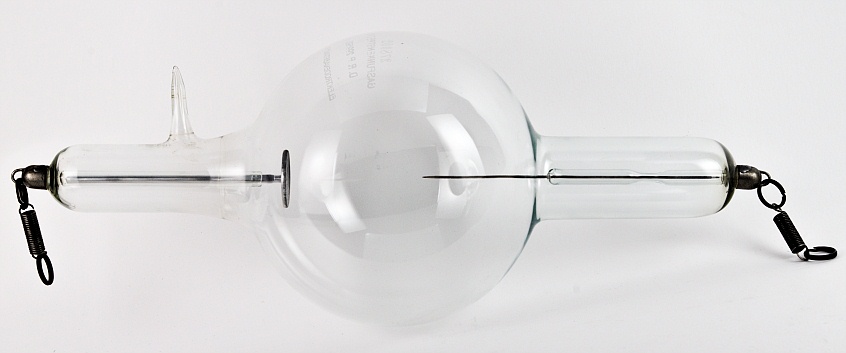
Click to enlarge
Longueur • Length • Länge : 38.2 cm • 15"
Diamètre • Diameter • Durchmesser : 15 cm • 5" 7/8
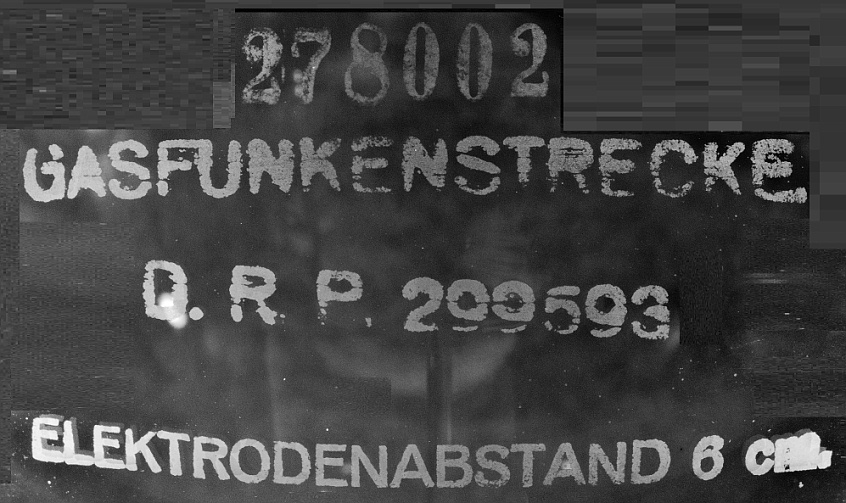
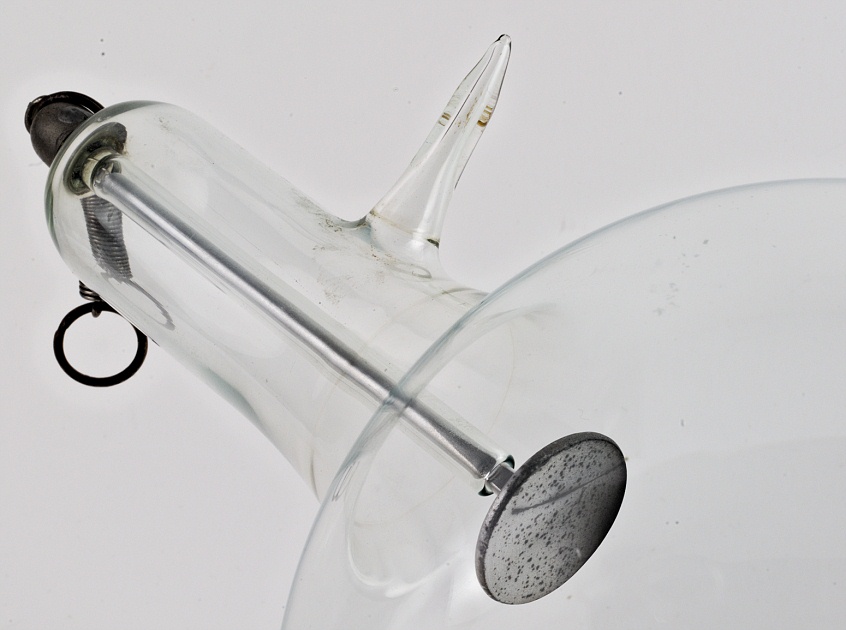

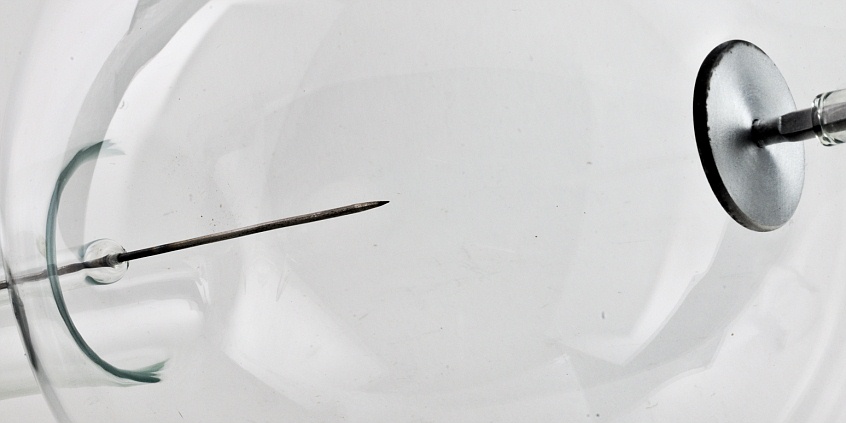
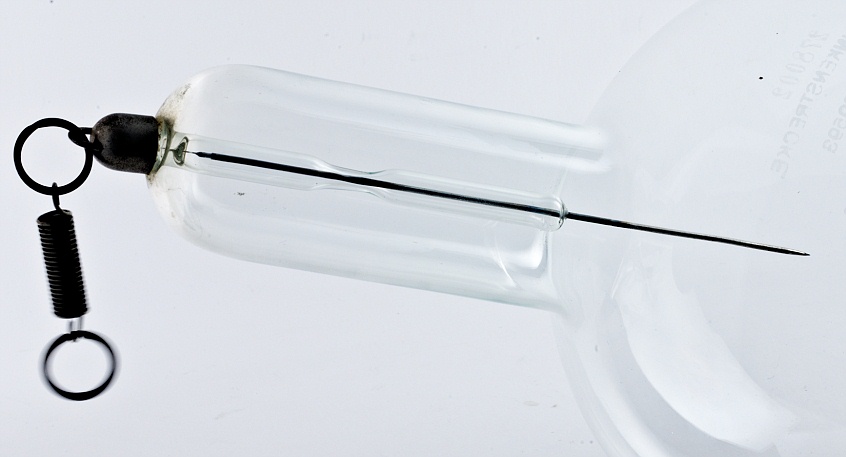
Le contenu de ce site est sous copyleft  The content of this site is under copyleft
The content of this site is under copyleft  Der Inhalt dieser Website steht unter Copyleft
Der Inhalt dieser Website steht unter Copyleft
